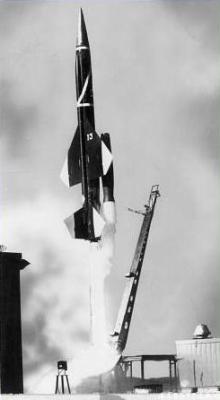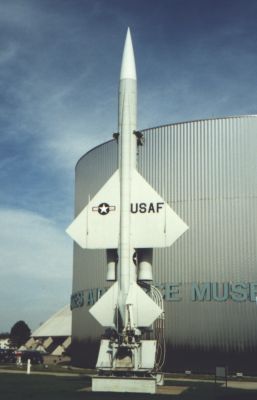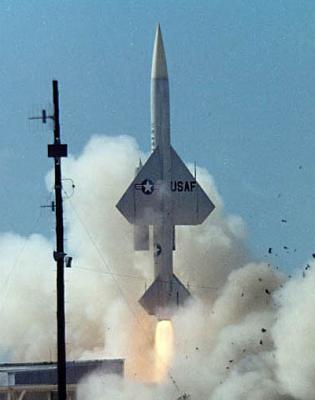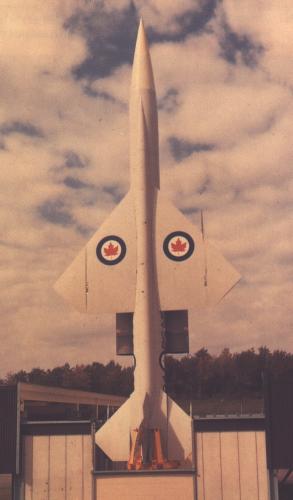Boeing SAM-A-2/F-99/IM-69/IM-99/CIM-10 Bomarc
The Bomarc was the only surface-to-air missile ever deployed by the U.S. Air Force. All other U.S. land-based SAMs were and are under the control of the U.S. Army.
In 1946, Boeing started to study surface-to-air guided missiles under the USAAF project MX-606. By 1950, Boeing had launched more than 100 test rockets in various configurations, all under the designator XSAM-A-1 GAPA (Ground-to-Air Pilotless Aircraft). Because these tests were very promising, Boeing received a USAF contract in 1949 to develop a pilotless interceptor (a term then used by the USAF for air-defense guided missiles) under project MX-1599. The MX-1599 missile, initially designated as XSAM-A-2, was to be a ramjet-powered, nuclear-armed long-range surface-to-air missile to defend the continental USA from high-flying bombers. The Michigan Aerospace Research Center (MARC) was added to the project soon afterwards, and this gave the new missile its name Bomarc (for Boeing and MARC). In 1951, the USAF decided to emphasize its point of view that missiles were nothing else than pilotless aircraft by assigning aircraft designators to its missile projects, and anti-aircraft missiles received F-for-Fighter designations. The SAM-A-2 Bomarc became the F-99.
Test flights of XF-99 test vehicles began in September 1952 and continued through early 1955. The XF-99 tested only the liquid-fueled booster rocket, which would accelerate the missile to ramjet ignition speed. In February 1955, tests of the XF-99A propulsion test vehicles began. These included live ramjets, but still had no guidance system or warhead. The designation YF-99A had been reserved for the operational test vehicles. In August 1955, the USAF discontinued the use of aircraft-like type designators for missiles, and the XF-99A and YF-99A became XIM-99A and YIM-99A, respectively. Originally the USAF had allocated the designation IM-69, but this was changed (possibly at Boeing's request to keep number 99) to IM-99 in October 1955. In October 1957, the first YIM-99A production-representative prototype flew with full guidance, and succeeded to pass the target within destructive range. In late 1957, Boeing received the production contract for the IM-99A Bomarc A interceptor missile, and in September 1959, the first IM-99A squadron became operational.
 |
 | |
| Photo: USAF | Photo: Author | |
| YIM-99A | IM-99A (CIM-10A) |
The operational IM-99A missiles were based horizontally in semi-hardened shelters ("coffins"). After the launch order, the shelter's roof would slide open, and the missile raised to the vertical. After the missile was supplied with fuel for the booster rocket, it would be launched by the Aerojet General LR59-AJ-13 booster. After supersonic speed was reached, the Marquardt RJ43-MA-3 ramjets would ignite and propel the missile to its cruise speed and altitude of Mach 2.8 at 20000 m (65000 ft). The Bomarc was guided to the target by ground commands from SAGE (Semi-Automatic Ground Environment), whose long-range radars tracked the enemy aircraft and the interceptor aircraft and missiles. When the Bomarc was within 16 km (10 miles) of the target, its own Westinghouse AN/DPN-34 radar guided the missile to the interception point. The maximum range of the IM-99A was 400 km (250 miles), and it was fitted with either a conventional high-explosive or a 10 kT W-40 nuclear fission warhead.
 |
| Photo: Boeing |
| IM-99B (CIM-10B) |
The liquid-fuel booster of the Bomarc A was no optimal solution. It took 2 minutes to fuel before launch, which can be long time in high-speed intercepts, and its hypergolic fuels were very dangerous to handle, leading to several severe accidents. As soon as high-thrust solid-fuel rockets became a reality in the mid-1950s, the USAF began to develop a new solid-fueled Bomarc variant, the IM-99B Bomarc B. It used a Thiokol XM51 booster, and also had improved Marquardt RJ43-MA-7 ramjets. The first IM-99B was launched in May 1959, but problems with the new propulsion system delayed the first fully successful flight until July 1960, when a supersonic KD2U-1/MQM-15A Regulus II drone was intercepted. Because the new booster took up less space in the missile, more ramjet fuel could be carried, increasing the range to 710 km (440 miles). The terminal homing system was also improved, using the world's first pulse doppler search radar, the Westinghouse AN/DPN-53. All Bomarc Bs were equipped with the W-40 nuclear warhead. In June 1961, the first IM-99B squadron became operational, and Bomarc B quickly replaced most Bomarc A missiles. The IM-99B was also used by Canada, after this country had cancelled its advanced CF-105 Arrow manned interceptor.
 |
| Photo: USAF Space Command |
| IM-99B (CIM-10B) |
In June 1963, the IM-99A and IM-99B missiles were redesignated as CIM-10A and CIM-10B, respectively. The Bomarc A was retired soon afterwards, the last CIM-10A being phased out in December 1964. Withdrawal of the CIM-10B also began in the mid-1960s, and by 1969 most missile sites had been deactivated. Finally, in April 1972, the last Bomarc B in USAF service was retired. The Bomarc, designed to intercept relatively slow manned bombers, had become a useless asset in the era of the intercontinental ballistic missile.
The remaining Bomarc missiles were used by all armed services as high-speed target drones for tests of other air-defense missiles. The Bomarc A and Bomarc B targets were designated as CQM-10A and CQM-10B, respectively. When production had ceased in 1965, about 700 Bomarc missiles of all versions had been built by Boeing.
Specifications
Note: Data given by several sources show slight variations. Figures given below may therefore be inaccurate!
Data for CIM-10A/B:
| CIM-10A | CIM-10B | |
|---|---|---|
| Length | 14.2 m (46 ft 9 in) | 13.7 m (45 ft 1 in) |
| Wingspan | 5.54 m (18 ft 2 in) | |
| Diameter | 0.89 m (35 in) | |
| Weight | 7020 kg (15500 lb) | 7250 kg (16000 lb) |
| Speed | Mach 2.8 | Mach 3 |
| Ceiling | 20000 m (65000 ft) | 30000 m (100000 ft) |
| Range | 400 km (250 miles) | 710 km (440 miles) |
| Propulsion | Boost: Aerojet General LR59-AJ-13 liquid-fuel rocket; 156 kN (35000 lb) Sustain: 2x Marquardt RJ43-MA-3 ramjet; 51 kN (11500 lb) each |
Boost: Thiokol M51 solid-fuel rocket; 222 kN (50000 lb) Sustain: 2x Marquardt RJ43-MA-7 ramjet; 53 kN (12000 lb) each |
| Warhead | W-40 nuclear fission (7-10 kT); CIM-10A had option for conventional HE | |
Main Sources
[1] James N. Gibson: "Nuclear Weapons of the United States", Schiffer Publishing Ltd, 1996
[2] Bill Gunston: "The Illustrated Encyclopedia of Rockets and Missiles", Salamander Books Ltd, 1979
Back to Current Designations Of U.S. Unmanned Military Aerospace Vehicles
Back to Directory of U.S. Military Rockets and Missiles
Last Updated: 21 January 2025